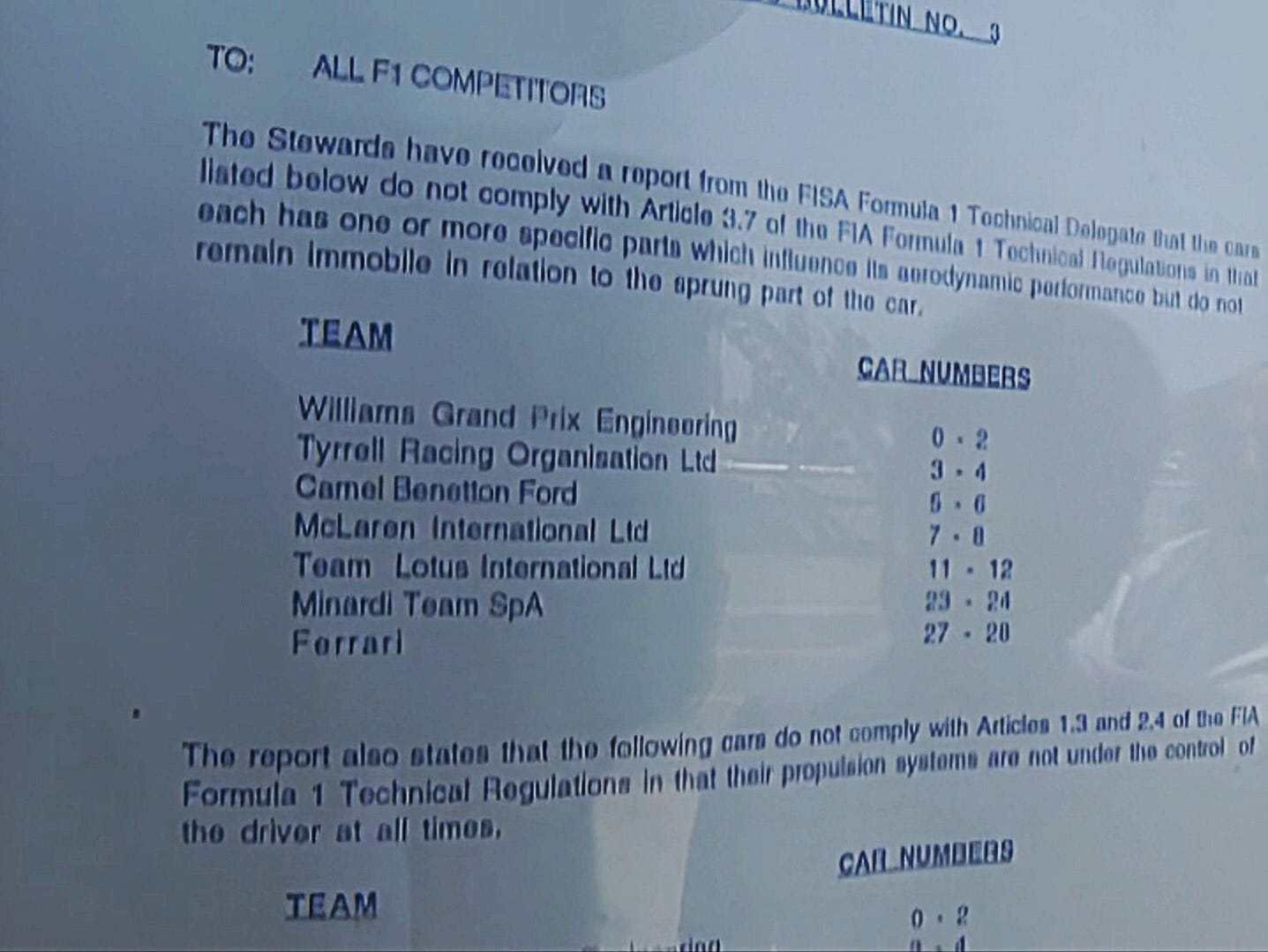On June 12, 1993, the day of the Saturday qualifying session for the Canadian Grand Prix in Montreal, the stewards released a report they had received from the FISA Technical Delegate, Charlie Whiting. The document stated that the cars of all competitors, except for a single Lola Ferrari, were in violation of technical regulations due to the use of active ride and traction control.
This public stunt was perceived as a power play by the governing body in its ongoing conflict with Williams and McLaren. FISA aimed to abolish driving aids for 1994, while the two aforementioned teams were firmly against it.
What’s FISA?
Fédération Internationale du Sport Automobile (FISA) was the governing body of Formula 1 until 1993. Max Mosley led it since 1991. After becoming the FIA President in 1993, the Brit disbanded the organization. Since 1994 Formula 1 has been under the jurisdiction of the FIA.
Driving Aids
Active suspension made its way into Formula 1 in the 1980s, but its brief period of prominence occurred at the beginning of the following decade, thanks to the almighty Williams FW14B.
Ferrari were the first team to use traction control at the end of the 1990 season, at Estoril. Williams implemented the system at the beginning of 1992, McLaren had it since the Hungarian Grand Prix, the same year. The last of the top teams to incorporate it into their car was Benetton – Monaco 1993.
In June, 1993, every competitor bar Lola, had either active suspension, or traction control, or both.
There were also semiautomatic and fully automatic gearboxes. Furthermore, Williams during the French Grand Prix, which was the next race after Canada, implemented ABS.
The Two Defiant Team Bosses
The ban on driving aids for 1994 was first announced on February 12, 1993, during a meeting of the F1 Commission, consisting of FISA and the teams. The regulatory changes aimed to reduce costs and place greater emphasis on drivers, as active ride and other new technologies were perceived to diminish individual skills.
This didn’t sit well with Frank Williams and Ron Dennis, whose teams had invested the most money in driving aids. Williams had won both championships the previous year largely due to active suspension and traction control. McLaren hoped to close the gap with their rival through the development of the technologies.
The proposed changes would peg them back and benefit their competitors. Understandably, they were reluctant to just throw their investments down the drain. And they had the Concorde Agreement on their side.
Regulations changes had to be unanimously approved by FISA and all teams and announced at least one full season in advance, unless they were implemented for safety reasons.
Williams and McLaren clearly disapproved and even threatened legal action.
Max Mosley Brings Chaos
During the Monaco Grand Prix weekend, FISA received support from Walter Tohma, the President of Philip Morris. He applauded the proposed changes and criticized the “self-interest in F1.” Given that Marlboro, the most famous of Philip Morris’ brands, was the title sponsor of McLaren, the company's backing exerted public pressure on one of the defiant teams.
FISA followed through and performed the stunt described in the first paragraph of this post. The move intended to show Williams and McLaren “that they needn’t bother threatening to take FISA to international law for breaking the Concorde Agreement when the teams themselves were already breaching technical regulations,” as noted by David Tremayne.
The journalist also cynically pointed out that FISA had seen nothing contravening the rules regarding active suspension and traction control in the past year and a half.
In Canada, the stewards permitted the teams accused of violating the rules to participate in the Grand Prix and referred the case to the governing body.
A month later, on July 15, FISA’s World Motorsport Council banned the two driving aids with immediate effect. It also issued reprimands to Williams and McLaren.
Officially only one team in Formula 1 had a legal car.
Bernie Ecclestone Brings Peace
The top teams found themselves on thin ice, but they didn’t remain idle and wait for it to crack. During the French Grand Prix weekend, the first race following Mosley’s power play in Canada, key personnel from Williams, McLaren, Benetton, and Ferrari were seen discussing their situation. They also talked to Bernie Ecclestone, and he found a solution… however not the one that Williams and McLaren wanted.
When the teams convened at Hockenheim for the German Grand Prix, the first race following the declaration of two offending driving aids as illegal by the World Motorsport Council, Ecclestone persuaded the constructors to sign a document… banning for 1994, among other things, active suspension, traction control and ABS. Only semiautomatic gearboxes were green-lighted, even though FISA had intended to ban them at the beginning of the year.
Max and Bernie called all the team principals together at Hockenheim in 1993 and told them that if they didn’t agree to ban some of the new technology, including active ride, and sign an agreement that night, they would be witnessing the death knell of Formula 1 as they knew it.
The Duopoly
In exchange for signing the document the teams were allowed to finish the season, without altering their machinery.
On August 2, FISA magnanimously annulled the reprimands for Williams and McLaren after both teams had lost their protest against the active suspension ban in the International Court of Appeal.
The entire saga marked the first instance of Ecclestone and Mosley strong-arming teams into accepting their terms, as a cynic would say. The balance of power in the sport remained relatively unchanged until 2009, when the constructors broke the Ecclestone-Mosley duopoly.




